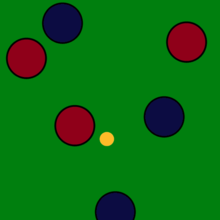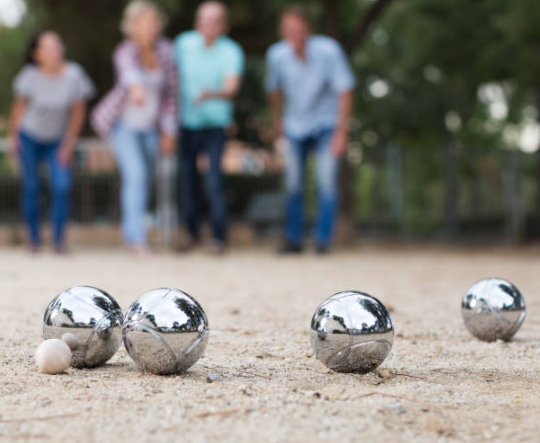Introduction and Summary from https://en.wikipedia.org/wiki/Petanque
Petanque isis a sport that falls into the category of boules sports (along with raffa, bocce, boule lyonnaise, lawn bowls, crown green bowling). In these sports, players or teams play their boules/balls towards a target ball.[1] In pétanque the objective is to score points by having boules closer to the target than the opponent after all boules have been thrown. This is achieved by throwing or rolling boules closer to the small target ball, officially called a jack[2] (French: cochonnet),[3] or by hitting the opponents’ boules away from the target, while standing inside a circle with both feet on the ground. The game is normally and best played on hard dirt or gravel. It can be played in public areas in parks or in dedicated facilities called boulodromes.
Playing the game[edit]
Based on the rules of the Fédération Internationale de Pétanque & Jeu Provençal.[2]
Equipment[edit]
Pétanque is played by two teams, each comprising one, two, or three players. In the singles and doubles games, each player plays with three metal boules. In triples, each player uses only two.
The area where a game of pétanque is played is called a terrain. A game can be played in an open area such as a public park, where the boundaries of the terrain are not marked, or more formally on a “marked terrain” where the terrain boundaries are marked (traditionally, by strings tightly strung between nails driven into the ground).

In pétanque, players throw while standing in a circle (cercle). Traditionally, this was simply scratched in the dirt. From around 2005, red plastic “prefabricated” circles were introduced and are now widely used in formal games. A circle drawn on the ground must be 35–50 cm (14–20 in) in diameter, while a plastic circle must have an inside diameter of 50 cm (20 in).
The “ends”[edit]
A game consists of several “ends” (mènes). An end consists of the throwing out of the jack (cochonnet, the little wooden target ball), followed by the two teams throwing their boules. After both teams have thrown all of their boules, the team with the boule closest to the jack wins the end. The winning team scores one point for each of its boules that is closer than the opposing team’s closest boule. That means that the winning team could in theory score as many as six points in an end, although a score of one or two points is more typical. As the game progresses, each team accumulates points until one of the teams reaches 13, the winning number of points.
Order of play[edit]
A game begins with a coin toss to determine which team plays first. The team that wins the toss begins the game by placing the circle, then standing in the circle and throwing the jack to a distance of 6–10 metres (20–33 ft). A player from the team that threw the jack throws the first boule. Then a player from the opposing team throws a boule. From that point on, the team with the boule that is closest to the jack is said to “have the point”. The team that does not have the point throws the next boule. That team continues to throw boules until it either gains the point, or runs out of boules.
If at any point the closest boules from each team are equidistant from the jack, then the team that threw the last boule throws again. If the boules are still equidistant then the teams play alternately until the tie is broken. If the boules are still equidistant at the end of the mène then neither team scores any points.
The team that won the end starts the next end. A player from the winning team places (or draws) a circle around the jack. The player then picks up the jack, stands in the circle, and throws the jack to start the next end.
Scoring[edit]


An end is complete when both teams have played all of their boules, or when the jack is knocked out of play (goes “dead”).
If the end finishes in the usual way—with the jack still live and one team with the closest boule—then the team with the closest boule wins the end and scores one point for each of its boules that is closer to the jack than other team’s closest boule.
If the jack is live but there is an “equidistant boules” situation at the end of the mène, then neither team scores any points. If the jack is dead at the finish of the end, then if one (and only one) team still has boules left to play, that team scores one point for each boule that it still has in hand. Otherwise neither team scores any points in the end (like an inning in baseball in which neither team scores any runs).
Miscellaneous rules[edit]
- Boules can be thrown in any way that the player wishes, but the traditional way is to hold the boule with the palm of the hand downwards, and then to throw with an under-arm swing of the arm ending in an upward flick of the wrist. Throwing this way puts backspin on the boule and gives the player the maximum amount of control and flexibility when throwing.
- The boule can be rolled, thrown to a moderate height, or even thrown to a great height (a high lob or portée).
- Players usually carry a tape measure for measuring close points.
- At the beginning of an end, before throwing the jack, if there isn’t enough room for the player to throw the jack to the maximum legal distance of 10 metres (33 ft), then the player is allowed to move the circle back to a point where there is enough room.
- On a terrain with boundaries marked with strings, a boule or jack must completely cross the boundary string before it is considered to be out-of-bounds and dead.
Equipment specifications[edit]

Boules[edit]
Leisure boules are boules that do not meet the FIPJP standards for competition boules, but are less expensive than competition boules and completely adequate for “backyard” games. Unlike competition boules, leisure boules are a “one size fits all” affair—they come in one weight and size.
Competition boules must meet specifications set by the FIPJP. They must be hollow and made of metal (usually steel) with a diameter between 70.5 and 80 mm (2.78 and 3.15 in) and a weight between 650 and 800 g (23 and 28 oz). When purchasing competition boules, a purchaser has a choice of a number of characteristics, including the size, weight, and hardness of the boules, as well as the striations (patterned grooves on the surface of the boules).[12]
Jack[edit]
The jack, or target ball, is a small ball made of wood, traditionally boxwood or beechwood, 30 mm (1.2 in) in diameter.[13] In the past, jacks were often left “natural”—unfinished or with a clear finish—but nowadays they are often painted in bright colours. In French, the jack is known by a variety of names, including but (goal or target), cochonnet (piglet), bouchon (“little ball” in provençal language, not related to the French word “bouchon” that designates a bottle stopper), le petit (the little one), and gari (“rat“, also in provençal language).
Playing area[edit]
Pétanque can be played on almost any flat, open space. The ground may be irregular and interrupted by trees or rocks, and the surface is likely to be uneven, with some areas hard and smooth and other areas rough and stony. When an area is constructed specifically for the purposes of playing pétanque, the playing surface is typically loose gravel, decomposed granite, brick grog or crushed sea shell. Sandy beaches are not suitable, although light plastic boules are sometimes used to adapt the game for the beach. There is no requirement for backboards or sideboards (as in bocce), but dedicated playing areas are often enclosed in boards or some other structural barrier.
In France, village squares and park pathways are often used as pétanque playing areas. In addition, many towns have recreational facilities (boulodromes) constructed specifically for playing pétanque.
An area where a single pétanque game is played is called a terrain. A “playing area” (aire de jeu) is an area containing one or more terrains. For tournaments, a large playing area is subdivided and marked off (typically using nails and string) into rectangular marked terrains (also known as “lanes” (cadres) or “pistes”) so that multiple games may be carried on simultaneously. For tournament play, a marked terrain is a rectangle at least 4 metres (13 ft) wide and 15 metres (49 ft) long.[14]
Strategy[edit]
Pointing and shooting[edit]
Generally speaking, a player throws a boule with one of two objectives:[14]
- To make the boule come to rest in a particular spot, usually as close as possible to the jack. This is called pointing.
- To make the boule directly hit an opponent’s boule with the aim of knocking it away from the jack. This is called shooting.
The best throw is called a carreau. It is a shot that knocks away the opponent’s boule, leaving the thrown boule exactly in its place.[15]
Players who are skilful enough to shoot effectively are called ‘shooters’ (tireurs); players who usually point are called ‘pointers’ (pointeurs) As a matter of strategy, pointers play first and shooters are held in reserve in case the opponents place well. Good pointing is what scores points, but national and international championships are usually dominated by skilful shooters, who target any opposing boule that comes close to scoring.
Throwing a boule[edit]
Some strategic considerations involved in the throw of a boule include:
- A traditional maxim is boule devant, boule d’argent (“A ball in front is a money ball.”). A boule located closer to the player than the jack (“in front of the jack”) is much more valuable than one behind the jack. A boule in front blocks the opposing team from easy access to the jack, and it may also (intentionally or accidentally) be hit and pushed closer to the jack.
- If a player points a boule very close to the jack, it forces the opposing shooter to shoot it immediately. This may prove to be a disadvantage to a pointer who wants to keep that boule, or it can be advantageous if the pointer is trying to force the opposing shooter to exhaust their supply of boules.
- It is generally a bad idea for a player to shoot with their team’s last boule. In most cases, the better strategy is to “limit the damage” by pointing the team’s last boule close enough to the jack to limit the opposing team’s gains to a single point.
Throwing the jack[edit]
Strategic considerations involved in the throw of the jack include:
- Throw the jack to a distance at which your own shooter is most comfortable, or the opposing shooter is least comfortable.
- Aim for a location on the terrain that your own pointers prefer, or that might be difficult for the opposing team’s pointers.
- Disorient the opposing team by refusing to get in a rut. At each opportunity, throw the jack to a new position on the terrain, and alternate long and short distances.

